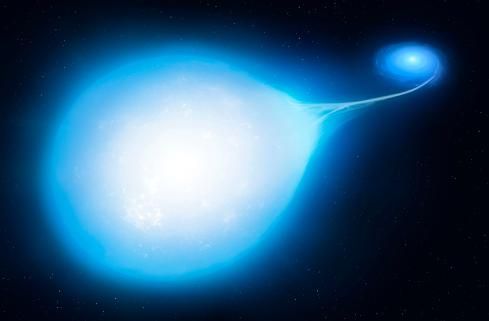Sometimes loud explosions are easier to deal with when you know they’re coming. They are also easier to watch out for. So when astronomers from the University of Warwick found a rare tear-drop shaped star, known as HD265435, they knew they were looking at a potential new supernova waiting to happen. The only caveat – it might not actually happen until 70 million years from now.
That might be an absurdly long time in human terms, but in astronomical terms it is the blink of an eye. Luckily, TESS, the telescope used to capture the data for the paper describing the system, which was published in Nature Astronomy, doesn’t have to blink. Originally designed to capture transits of exoplanets, TESS is especially good at quantifying slight dips in a star’s brightness. Sometimes, these dips are caused by planets moving in front of the star. But there are other explanations for dips in brightness as well.

Credit – Simbad / University of Strasbourg
One alternate explanation for varying brightness is if the star was deformed. In the case of HD265435, it resembles a teardrop rather than the spherical ball of fire traditional stars resemble. So what would make a star deform into such a shape? The answer appears to be – another star. The star that is visibly dimming in brightness is known as a “hot subdwarf” – a type of star that is slightly less bright than the sun. Calculations that Dr. Ingrid Pelisoli, the lead author on the paper, made using radial velocity data from Palomar and the Keck Observatory showed that the relatively bright hot subdwarf star was in fact probably hiding a much dimmer white dwarf companion.
Given the proximity of the two stars, it seems inevitable that they will eventually fall into each other. They’ve already begun spiraling around each other, rotating around each other every 100 minutes. But what makes this combination particularly interesting is the fact that one of the companions is a white dwarf.
White dwarfs are thought to cause Type 1a supernovae when their core reignites, burning with a fire so bright and consistent that it helps astronomers determine the speed of the universe’s expansion. This can potentially happen when the total mass of white dwarf and its surrounding stars have a total mass greater than the Chandrasekhar limit, or about 1.4 times the mass of the Sun. The combined mass of the hot subdwarf (about .6 times the mass of our Sun) and the white dwarf (similar to the mass of our Sun) exceeds that limit. As such, the system should go supernova when the mass is gravitationally crushed in the core of the white dwarf.
This system is one of only a few that are expected to produce supernovae in the (relatively) near future. And this is the only one that contained a hot subdwarf and white dwarf binary system. Estimates for the total number of supernovae expected in a given area can be gleaned both from methods of looking at other galaxies and also at modeling stellar evolution. But given those estimates of how many supernovae researchers expect to happen in our own galaxy, there aren’t very many candidates system where we are expecting them to happen. That means, despite occasionally finding systems where it’s clear one will happen, we might get some unexpected explosions after all.
Learn More:
University of Warwick – Teardrop star reveals hidden supernova doom
Nature Astronomy – A hot subdwarf–white dwarf super-Chandrasekhar candidate supernova Ia progenitor
Live Science – Rare ‘teardrop’ star and its invisible partner are doomed to explode in a massive supernova
Sci-News – HD 265435 Will Explode as Type Ia Supernova in 70 Million Years, Astronomers Say
UT – White Dwarf Measured Before it Exploded as a Supernova
Lead Image:
Artist’s depiction of the teardrop shape of the HD265435 System.
Credit – University of Warwick / Mark Garlick


An excellent find. Much can be learned on how Type IA supernovas are produced by observing and measuring this system. The white dwarf has enough mass around it to blow itself to bits right now, but it is not concentrated enough yet to ignite.